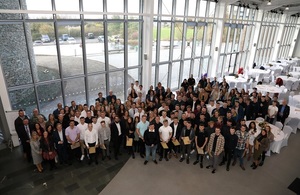UK and Estonia commit to closer defence cooperation
- UK Apache and Chinook helicopters to deploy to Estonia periodically from January 2023.
- Exercise Spring Storm will take place in Estonia in May next year – part of more regular deployments high readiness forces.
- UK to support development of Estonia’s warfighting Division and provide a Brigadier to lead the enhanced Forward Presence Battlegroup.
The United Kingdom will periodically deploy helicopters to Estonia as part of enhancing our nations’ deep defence relationship built on shared interests and values. The Defence Secretary Ben Wallace hosted his counterpart Estonian Minister of Defence Hanno Pevkur in London for a meeting, during which the Ministers committed to stronger ties and issued a joint statement. A Guard of Honour welcomed Minister Pevkur on arrival.
The Ministers signed a roadmap which sets out a shared plan to implement commitments made at the NATO Summit in Madrid earlier this year. The roadmap will see a more capable UK presence in Estonia, continuing our commitment to deter aggression and defend European and NATO security.
UK Defence Secretary Ben Wallace said:
The UK’s commitment to Estonia and European defence and security is unwavering. The deployment of assets such as Apache and Chinook helicopters to exercise in Estonia is a clear example of the strength of our relationship, and the importance we place on our ability to effectively operate side by side.
Estonia Defence Minister Hanno Pevkur said:
In the roadmap, Estonia have committed to start the development of an Estonian warfighting Division which will ensure coordinated use of national and allied forces in the defence of Estonia. This work will be supported by the UK, who are providing training and mentoring through an advisory team and close links with the UK’s 3rd Division.
The UK has an enhanced forward presence (eFP) Battlegroup in Estonia, and this deployment will be enhanced through divisional-level assets such as short range air defence and multiple rocket launch systems in the country. These will be augmented with periodic deployments of additional capabilities including Apache and Chinook helicopters. The first of these surges will begin January 2023, when Chinook Helicopters will deploy to Estonia.
From April 2023, the UK’s eFP Headquarters in Estonia will be led by a Brigadier, enhancing the HQ’s capabilities. In addition, the UK will hold a Brigade sized force at high readiness in the UK, ready to reinforce Estonia and the Baltics at a time of need. These forces will regularly exercise in Estonia and the first exercise, Spring Storm, is planned for May 2023.
Estonia is supporting these plans by building four additional accommodation halls and other necessary support facilities at Tapa Camp which will be completed before the exercise begins.
Separately, the UK will be providing Baltic Air Policing in Estonia from March to July 2023 using Typhoon aircraft and will continue to contribute to NATO maritime patrols in the Baltics.
Estonia and the UK are both part of the Joint Expeditionary Force (JEF), a group of ten European nations who work together in support of European security.

